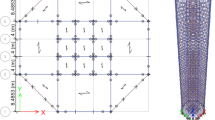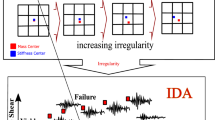Abstract
The main objective of this study is to employ a probabilistic approach to determine the appropriate value of the strong column-weak beam ratio (SCWBR) for three mid- to high-rise moment frames. These buildings are subjected to pulse-type ground motions. The nonlinear soil-structure interaction (SSI) is also involved as another seismic energy dissipation mechanism. A set of incremental nonlinear dynamic analyses are performed for 91 pulse-like ground motions. The proposed approach includes global and local performance criteria. Park-Ang damage index is utilized as the damage measure for columns. In this regard, simple mathematical equations are also derived to quantify the impact of the SCWBR. This framework introduces an upper bound on the SCWBR beyond which further increase of this parameter would not be required to limit the damage of columns. The results indicate that for the 4-story building, the applicability of the SCWBR extends to values as large as 2.4, while for the 8 and 12-story buildings, this is restricted to 1.8 and 1.6, respectively. However, these values substantially depend on the pulse period in such a way that the SCWBR of 1.2 would be sufficient when the pulse period is approaching the fundamental period of structures. The SSI may improve the collapse probability of high-rise structures to a larger extent compared to SCWBR. Nevertheless, its effect can be diminished by more damage of columns at the lower portion of buildings.
















Similar content being viewed by others
Availability of data and material
Not applicable.
Code availability
The OpenSees software, developed by the Pacific Earthquake Engineering Research Center (PEER), has been used for the dynamic analysis of this paper. This software can be accessed at https://opensees.berkeley.edu/.
References
ACI Committee 318 (2014) Building code requirements for structural concrete (318–14) and commentary. Farmington Hills, MI
Alavi B, Krawinkler H (2004) Behavior of moment-resisting frame structures subjected to near-fault ground motions. Earthq Eng Struct Dyn 33:687–706
ANSI/AISC 341-16 (2016) Seismic Provisions for Structural Steel Buildings. American Institute of Steel Construction Inc, Chicago, IL
Archila M, Ventura CE, Finn WDL (2017) New insights on effects of directionality and duration of near - field ground motions on seismic response of tall buildings. Struct Des Tall Spec Build 26:1–14
ASCE/SEI 7-16 (2016) Minimum design loads for buildings and other structures. American Society of Civil Engineers
ATC 63 (2009) Quantification of building seismic performance factors, FEMA P695. Redwood City, CA.
Bai J, Ou J (2012) Plastic limit-state design of frame structures based on the strong-column weak-beam failure mechanism. In: 15th world conference on earthquake engineering (15WCEE)
Baker JW (2007) Quantitative classification of near-fault ground motions using wavelet analysis. Bull Seismol Soc Am 97:1486–1501
Cagurangan C, Moehle JP (2015) Effects of strong-column weak-beam ratios on collapse capacities of tall reinforced concrete moment frame structures. University of California, Berkeley
Cavalieri F, Correia AA, Crowley H, Pinho R (2020) Dynamic soil-structure interaction models for fragility characterisation of buildings with shallow foundations. Soil Dyn Earthq Eng 132:
Champion C, Liel A (2012) The effect of near-fault directivity on building seismic collapse risk. Earthq Eng Struct Dyn 41:1391–1409
Chopra AK (1995) Dynamics of structures: theory and applications to earthquake engineering. Prentice-Hall, University of California at Berkeley
Chopra AK, Chintanapakdee C (2001) Comparing response of SDF systems to near-fault and far-fault earthquake motions in the context of spectral regions. Earthq Eng Struct Dyn 30:1769–1789
Costa A, Romão X, Oliveira CS (2010) A methodology for the probabilistic assessment of behaviour factors. Bull Earthq Eng 8:47–64. https://doi.org/10.1007/s10518-009-9126-5
Dooley KL, Bracci JM (2001) Seismic evaluation of column-to-beam strength ratios in reinforced concrete frames. ACI Struct J 98:843–851
Eurocode 8 (2004) Design of structures for earthquake resistance - Part 1: General rules, seismic actions and rules for buildings (En 1998–1). European Committee for Standardization
Fardis MN (2009) Seismic design and retrofit of concrete buildings based on EN-Eurocode 8. Springer Science & Business Media
Galal K, Naimi M (2008) Effect of soil conditions on the response of reinforced concrete tall structures to near- fault earthquakes. Struct Des Tall Spec Build
Gazetas G (1991) Foundation vibrations. Chapman and Hall, Fang HY
Gazetas G, Anastasopoulos I, Adamidis O, Kontoroupi T (2013) Nonlinear rocking stiffness of foundations. Soil Dyn Earthq Eng 47:83–91. https://doi.org/10.1016/j.soildyn.2012.12.011
Ghorbanzadeh M, Khoshnoudian F (2020) The effect of strong column-weak beam ratio on the collapse behaviour of reinforced concrete moment frames subjected to near-field earthquakes. J Earthq Eng. https://doi.org/10.1080/13632469.2020.1822228
Gillie JL, Rodriguez-Marek A, McDaniel C (2010) Strength reduction factors for near-fault forward-directivity ground motions. Eng Struct 32:273–285
Güllü H, Karabekmez M (2017) Effect of near-fault and far-fault earthquakes on a historical masonry mosque through 3D dynamic soil-structure interaction. Eng Struct 152:465–492
Guo G, Qin L, Yang D, Liu Y (2020) Dimensional response analysis of rocking wall-frame building structures with control devices subjected to near-fault pulse-like ground motions. Eng Struct. https://doi.org/10.1016/j.engstruct.2020.110842
Haselton CB, Deierlein GG (2007) Assessing seismic collapse safety of modern reinforced concrete moment-frame buildings. Stanford University
Ibarra LF, Krawinkler H (2005) Global Collapse of Frame Structures under Seismic Excitations (PEER Report). Stanford, CA
Ji X, Kato M, Wang T et al (2009) Effect of gravity columns on mitigation of drift concentration for braced frames. J Constr Steel Res 65:2148–2156. https://doi.org/10.1016/j.jcsr.2009.07.003
Ji K, Ren Y, Wen R, Kuo C (2019) Near-field velocity pulse-like ground motions on February 6 , 2018 M W 6.4 Hualien, Taiwan earthquake and structural damage implications. Soil Dyn Earthq Eng 126:105784
Kalkan E, Kunnath SK (2006) Effects of fling step and forward directivity on seismic response of buildings. Earthq Spectra 22:367–390
Kappos AJ (1997) Influence of capacity design method on the seismic response of RC columns. J Earthq Eng 1:341–399
Karapetrou ST, Fotopoulou SD, Pitilakis KD (2015) Seismic vulnerability assessment of high-rise non-ductile RC buildings considering soil–structure interaction effects. Soil Dyn Earthq Eng 73:42–57
Krishnan S, Muto M (2012) Mechanism of collapse of tall steel moment-frame buildings under earthquake excitation. J Struct Eng 138:1361–1387. https://doi.org/10.1061/(asce)st.1943-541x.0000573
Kuntz GL, Browning J (2003) Reduction of column yielding during earthquakes for reinforced concrete frames. ACI Struct J 100:573–580
Li S, Zhang F, Wang J et al (2017) Seismic responses of super-span cable-stayed bridges induced by ground motions in different sites relative to fault rupture considering soil-structure interaction. Soil Dyn Earthq Eng 101:295–310
Lignos DG, Krawinkler H (2013) Development and utilization of structural component databases for performance-based earthquake engineering. J Struct Eng 139:1382–1394
Lin YY, Tsai MH, Hwang JS, Chang KC (2003) Direct displacement-based design for building with passive energy dissipation systems. Eng Struct 25:25–37
Macedo L, Silva A, Castro JM (2019) A more rational selection of the behaviour factor for seismic design according to Eurocode 8. Eng Struct 188:69–86
McKenna F (2011) OpenSees: a framework for earthquake engineering simulation. Comput Sci Eng 13:58–66. https://doi.org/10.1109/MCSE.2011.66
Moehle JP, Hooper JD, Lubke CD (2008) Seismic design of reinforced concrete special moment frames: a guide for practicing engineers (NIST GCR 8–917–1)
Mylonakis G, Nikolaou S, Gazetas G (2006) Footings under seismic loading: analysis and design issues with emphasis on bridge foundations. Soil Dyn Earthq Eng. https://doi.org/10.1016/j.soildyn.2005.12.005
Nakashima M, Sawaizumi S (2000) Column-to-beam strength ratio required for ensuring beam-collapse mechanisms in earthquake responses of steel moment frames. In: Proceedings of 12th world conference on earthquake engineering, Auckland, New Zealand
Nakhaei M, Ghannad MA (2008) The effect of soil-structure interaction on damage index of buildings. Eng Struct 30:1491–1499. https://doi.org/10.1016/j.engstruct.2007.04.009
NIST (2012) Soil-Structure Interaction for Building Structures. NIST GCR 12–917–21 Gaithersbu:Applied Technology Council
NZS 3101-1 (2006) Concrete structures standard - The design of concrete structures. Standards New Zealand
Öncü-Davas S, Alhan C (2019) Reliability of semi-active seismic isolation under near-fault earthquakes. Mech Syst Signal Process 114:146–164. https://doi.org/10.1016/j.ymssp.2018.04.045
Park Y, Ang AH-S, Wen YK (1985) Seismic damage analysis of reinforced concrete buildings. J Struct Eng 111:740–757
Pitilakis KD, Karapetrou ST, Fotopoulou SD (2014) Consideration of aging and SSI effects on seismic vulnerability assessment of RC buildings. Bull Earthq Eng
Qu B, Sanchez-Zamora F, Pollino M (2014) Mitigation of inter-story drift concentration in multi-story steel concentrically braced frames through implementation of rocking cores. Eng Struct 70:208–217. https://doi.org/10.1016/j.engstruct.2014.03.032
Raychowdhury P (2008) Nonlinear Winkler-based shallow foundation model for performance assessment of seismically loaded structures. University of California, San Diego
Raychowdhury P, Hutchinson TC (2009) Performance evaluation of a nonlinearWinkler-based shallow foundation model using centrifuge test results. Earthq Eng Struct Dyn 38:679–698
Ryan KL, Polanco J (2008) Problems with rayleigh damping in base-isolated buildings. J Struct Eng 134:1780–1784
Sattar S, Liel AB (2017) Collapse indicators for existing nonductile concrete frame buildings with varying column and frame characteristics. Eng Struct 152:188–201
SEAOC (1999) Recommended Lateral Force Requirements and Commentary. Seismology Committee, Structural Engineers Association of California
Sehhati R, Rodriguez-marek A, ElGawady M, Cofer WF (2011) Effects of near-fault ground motions and equivalent pulses on multi-story structures. Eng Struct 33:767–779
Uang C-M, Bertero VV (1990) Evaluation of seismic energy in structures. Earthq Eng Struct Dyn 19:77–90. https://doi.org/10.1002/eqe.4290190108
Vafaei M, Baniahmadi M, Alih SC (2019) The relative importance of strong column-weak beam design concept in the single-story RC frames. Eng Struct 185:159–170
Vamvatsikos D, Cornell CA (2002) Incremental dynamic analysis. Earthq Eng Struct Dyn 31:491–514
Whittaker A, Hart G, Rojahn C (1999) Seismic response modification factors. J Struct Eng 125:438–444
Wongpakdee N, Leelataviwat S (2017) Influence of Column Strength and Stiffness on the Inelastic Behavior of Strong-Column-Weak-Beam Frames. J Struct Eng 143:
Zaghi AE, Soroushian S, Itani A et al (2014) Impact of column-to-beam strength ratio on the seismic response of steel MRFs. Bull Earthq Eng 13:635–652
Zareian F, Krawinkler H (2007) Assessment of probability of collapse and design for collapse safety. Earthq Eng Struct Dyn 36:1901–1914. https://doi.org/10.1002/eqe
Zhang Y, Chen J, Sun C (2017) Damage-based strength reduction factor for nonlinear structures subjected to sequence-type ground motions. Soil Dyn Earthq Eng 92:298–311
Funding
The authors received no financial support for the research, authorship, and/or publication of this article.
Author information
Authors and Affiliations
Corresponding author
Ethics declarations
Conflict of interest
The authors report no conflicts of interest. The authors alone are responsible for the content and writing of this article.
Ethical approval
Not applicable.
Consent to participate
Not applicable.
Consent for publication
Not applicable.
Additional information
Publisher's Note
Springer Nature remains neutral with regard to jurisdictional claims in published maps and institutional affiliations.
Rights and permissions
About this article
Cite this article
Ghorbanzadeh, M., Khoshnoudian, F. & Taghikhany, T. A probabilistic model for the evaluation of strong column-weak beam provision for flexible-base buildings subjected to pulse-like ground motions. Bull Earthquake Eng 20, 997–1026 (2022). https://doi.org/10.1007/s10518-021-01262-2
Received:
Accepted:
Published:
Issue Date:
DOI: https://doi.org/10.1007/s10518-021-01262-2





